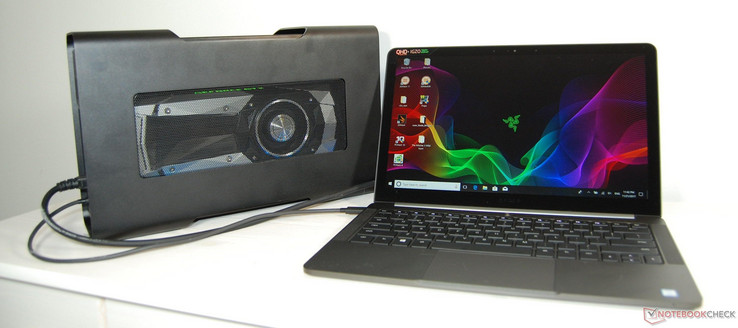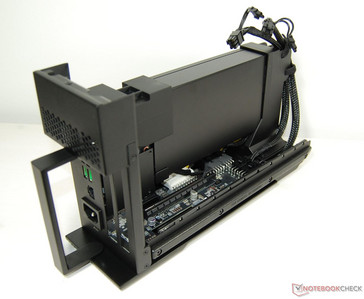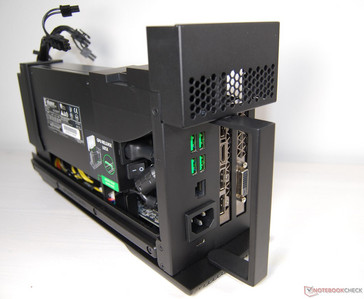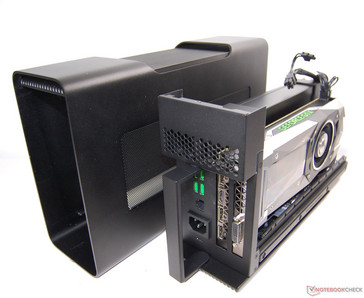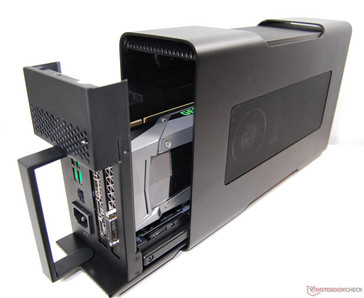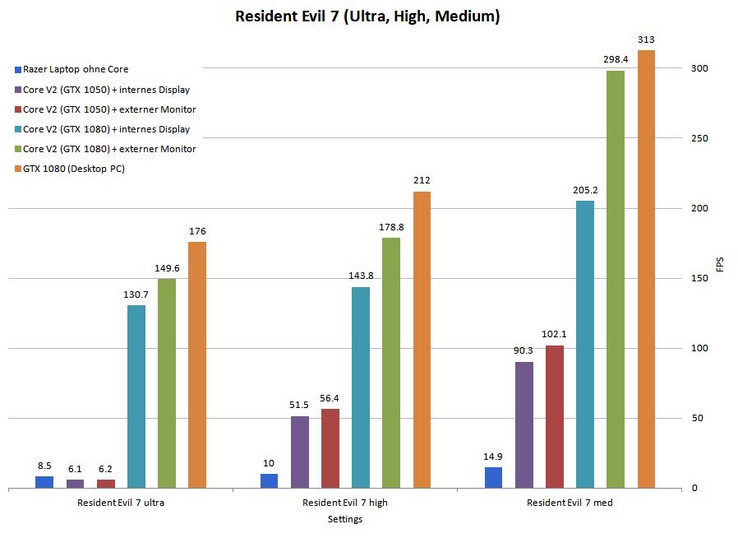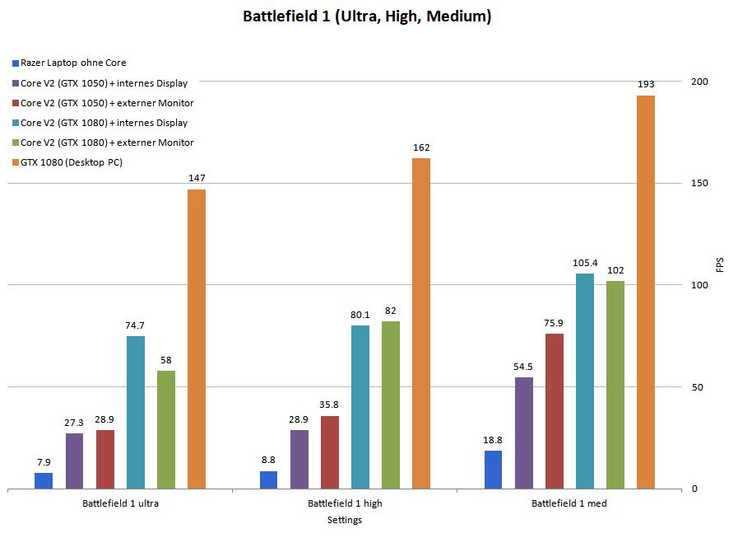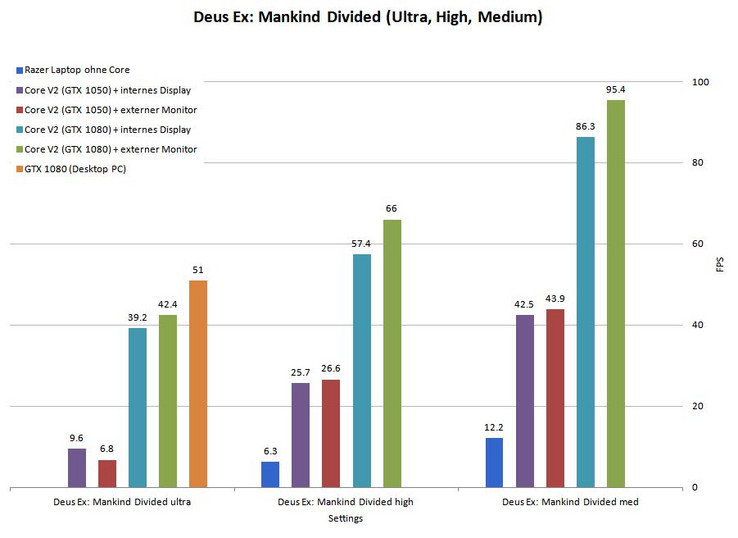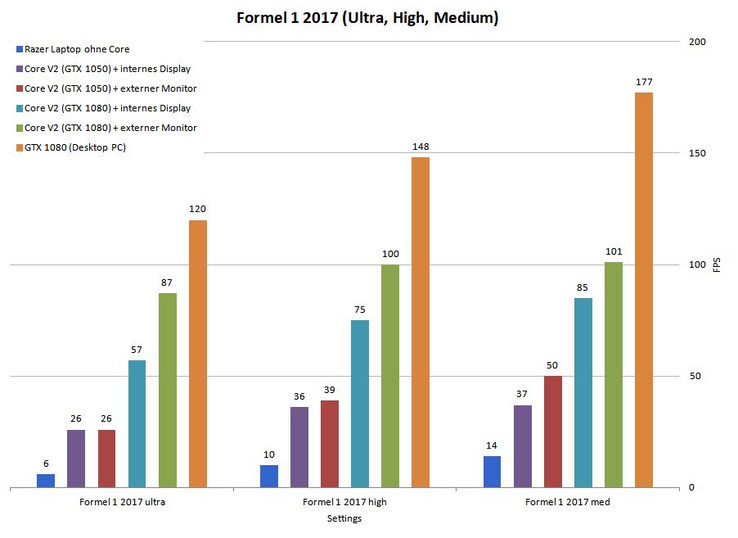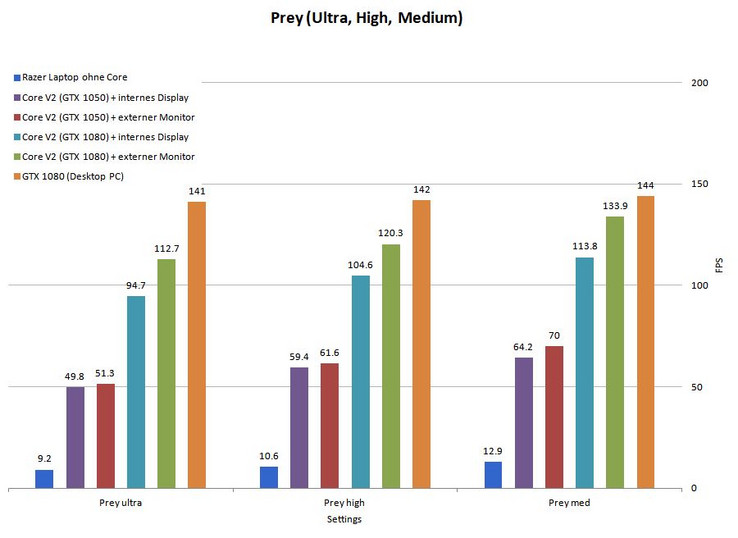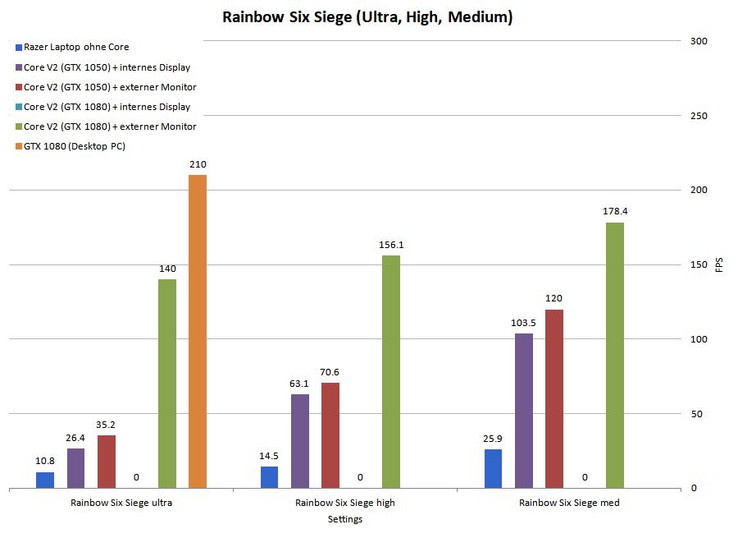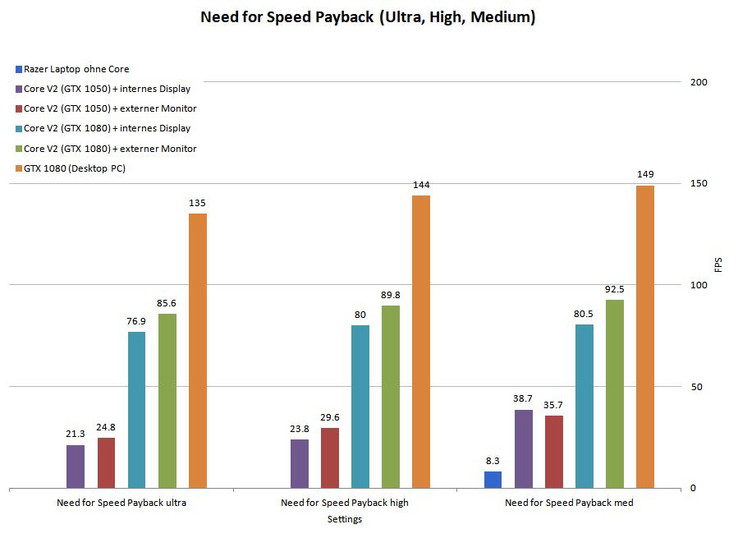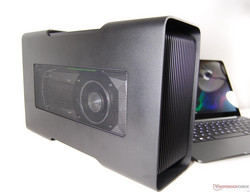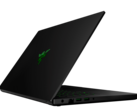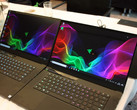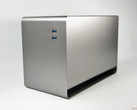Razer Core V2 + Blade Stealth (i7-8550U) Review
External graphics card solutions used to be too complicated for anyone besides DIY PC-builders, but today they are of widespread interest. To sit in the office with your slim ultrabook by day and play Call of Duty II with frame rates above 50 fps with the same computer by night – that is an alluring prospect for many. As a result, Thunderbolt 3 ports are becoming more and more prevalent. Not only do they offer sufficient bandwidth (40 Gbit/s), but the compatibility standard allows nearly every laptop equipped with a Thunderbolt port to connect to an external graphics card. Before the Thunderbolt port was conceived, only a select few laptops could be upgraded by means of an external graphics card. One such configuration consisted of a PCI Express card connected to a PE4H passive adapter. Today, more and more manufacturers are producing their own versions of this elegant solution – including ASUS, Gigabyte and HP, to name only a few.
Razer, a brand known for gaming products, has already released a successor to their first eGPU dock, the Razer Core V1. The company gave the new device a perfectly logical name: the "Razer Core V2". When the Razer Core V1 appeared on the market, we examined it closely. Our comprehensive review discussed its functionality, its case properties, and all its connectivity options. Because the Razer Core V2 is outwardly identical to its predecessor, this time we will only briefly cover its case and installation. Our main focus will be on the benchmark results from several of today's more graphics-intensive games. This time around, we are interested in the direct comparison between frame rates on our test laptop's internal display (Razer Blade Stealth i7-8550U) vs. an external monitor, the improvement in performance over our laptop on its own, and the graphics power of the laptop + eGPU combo compared to a desktop PC.
Core V1 vs. Core V2
As previously mentioned, the Razer Core V2 is outwardly identical to the first Core generation. In our hands, the CNC aluminum case feels very sturdy and cool. The enclosure weighs in at a hefty 3.5 kilograms (7.7 pounds), making it heavier than the laptop we chose to pair with the Core V2 to create our test system (the Razer Blade Stealth i7-8550U). The key modification to the Core V2 is the new TI82 controller. In the old version, one controller was responsible for both eGPU channels as well as the I/O ports. The Razer Core V2 is now equipped with two Thunderbolt 3 controllers, which means the graphics card, USB ports and the Ethernet port no longer need to share the bandwidth of a single controller. The graphics card alone does take up four PCIe lanes here, but let us not forget that the same graphics card in a desktop PC would occupy 16 PCIe lanes.
Inside, the space for the graphics card has expanded. Whereas previously the Core could only hold graphics cards with a maximum height of 13 centimeters (5.12 inches), now the enclosure has space for GPUs measuring up to 14.5 centimeters (5.71 inches) in height. The maximum length remains 30 centimeters (11.81 inches). The somewhat greater height allowance enables the user to install some 14.8 centimeter-high Zotac graphics cards from the 1070 and 1080 AMP series, or the 13.8 centimeter-high ASUS Strix Radeon R9 Fury, to name a few examples. Importantly, at a maximum of 4.3 centimeters (1.69 inches), width is still a constraint. Some potentially desirable graphics cards must be ruled out as a result of this restriction.
The Test System
What would match the Razer Core V2 better than a Razer laptop? This time, we decided to perform the benchmarks with the newest Razer Blade Stealth i7-8550U (in review here). But like the Core V1, the Core V2 can be connected to nearly every laptop with a Thunderbolt 3 port, regardless of brand. Equipped with an Intel i7-8550U CPU from the eighth and newest Intel generation, the Blade Stealth has four cores under its hood, even with the processor's energy-efficient "U" designation. The internal graphics card also received a small upgrade, though it is hardly worthy of mention. The integrated Intel UHD Graphics 620 now clocks at up to 1150 MHz with turbo, 100 MHz higher than the previous HD Graphics 620. We recently reviewed the Razer Blade Stealth i7-8550U and determined that it does not possess the necessary hardware to run graphics-intensive games. Current games just barely run fluently at minimum detail settings; all our attempts to play games at medium details failed. The fault lies with the weak UHD Graphics 620.
For this reason, we will use the Core V2 to stoke the fires under the Razer Blade Stealth's unibody. We prepared two graphics cards for the Core V2: the short Zotac GeForce GTX 1050 Mini (around 120 Euros; ~$150), and an Nvidia GeForce GTX 1080 Founders Edition (around 600 Euros; ~$712). We should mention that the Zotac card only occupies one slot, but the developers of the Razer Core designed the device to hold dual-slot GPUs. The GTX 1050 Mini is too small to be affixed with a screw, leaving it to sit rather loosely in the Core. Some ingenuity is required to mount the card reasonably securely in the case.
After this little problem is solved, the Core V2 is connected to the Razer Blade Stealth via the Thunderbolt 3 port, using a cable that is unfortunately only 50 centimeters long (~20 inches). With a speed of 40 Gbit/s, the Thunderbolt 3 connection is predestined for a working relationship with the Core. The connection is forged straightaway; after a reboot the new hardware is recognized. A colorful light show dances reassuringly on the device. The three fans on the underside of the Razer Core, on the other hand, make a less agreeable impression. But more on that in our verdict section.
We will run the benchmark five times per game.
- Razer Blade Stealth i7-8550U laptop with the integrated UHD Graphics 620 without the Razer Core V2
- Laptop with Core V2 (GTX 1050 Mini) with the internal laptop display
- Laptop with Core V2 (GTX 1050 Mini) with an external monitor
- Laptop with Core V2 (GTX 1080) with the internal laptop display
- Laptop with Core V2 (GTX 1080) with an external monitor
Three comparisons interest us: First, the contrast in gaming performance between the laptop alone without the Core V2 vs. with the Core V2 connected. Second, we want to determine whether the Razer Core V2 behaves differently when games are played on the internal laptop display vs. on an external monitor directly connected to the Core. In theory, the system should reach higher frame rates with an external monitor, given that the data stream only flows in one direction, so to speak: from the laptop via the Thunderbolt port to the Core, and from there directly to the external monitor. On the other hand, if the game is played on the internal display, the data has to pass through the Thunderbolt port back to the laptop. That certainly could cause bottlenecking in some games, which would cause the frame rate to fall. Last but not least, we are also interested to learn what kind of performance advantages a desktop PC has over the Razer Core V2, where the same graphics card has direct access to 16 PCIe lanes. Without further ado, let us take a look at the results.
Benchmarks
We ran the games in all of the above-mentioned configurations at ultra, high and medium detail settings. The resolution was always set to 1920x1080 pixels; the level of detail, as well as anti-aliasing and anisotropic-filtering settings, account for the differences between runs.
Resident Evil 7
Looking at the frame rates in the ultra setting, it is quite clear that Resident Evil 7 is an extremely graphics-intensive game. Both the internal UHD Graphics 620 and the GTX 1050 Mini are unable to keep up. But the GTX 1080 makes a quantum leap to over 100 fps – and that at ultra settings. At medium details, we see that the Thunderbolt port limits the frame rate substantially when the game is played on the internal display. Because the data flowing in and out of the Core V2 has to share the same highway when the graphics are displayed on the internal screen, an external monitor is very advantageous here. From a quantitative perspective, this is especially true when the Core V2 is equipped with the GTX 1080. This card processes more data than the Thunderbolt port can handle, particularly when the data has to flow back to the ultrabook. The theoretical difference between frame rates is enormous here – but in practice it is irrelevant whether the game is displayed on the monitor at 200 fps or 300 fps.
Battlefield 1
In Battlefield, however, it hardly makes a difference for the GTX 1080 whether the game is running on the laptop display or an external monitor. Interestingly, the choice of monitor does play a significant role for the GTX 1050 Mini at medium details. On the other hand, even the inexpensive GTX 1050 card is able to render Battlefield at ultra settings. The theoretical difference in performance between a desktop PC and the Core V2 with the same GTX 1080 is striking. The card is clearly limited by its access to just four PCIe lanes.
Deus Ex: Mankind Divided
The Razer Blade Stealth has no results listed under the ultra settings, as it was hopelessly ill-equipped to handle such high graphics demands. But on a positive note, we do not see a huge difference between the internal display and the external monitor here. Compared to Battlefield 1, the difference in performance between the laptop with the Core V2 and the desktop PC is relatively small as well.
Formula 1 2017
Stuttering is extremely detrimental in racing games. As soon as the player notices that the environment is not being rendered perfectly smoothly, concentration and reaction times suffer. Encouragingly, this bar graph once again shows little difference between the internal display and external monitor at ultra and high settings. Only at medium details does the choice of display make a real difference. Notably, even the GTX 1050 Mini manages to render the game fluently here – unlike the UHD Graphics 620, of course. A desktop PC with the same graphics card performs substantially better than the Razer Core.
Prey
Rainbow Six Siege
Unfortunately, in Rainbow Six the GTX 1080 let us down when we tried to play the game on the internal display. We believe this was a driver issue, as the Razer Blade reverted to the internal UHD Graphics 620 as the primary graphics card at the start of the game. With a bit of tinkering (perhaps uninstalling and reinstalling), the problem may have been solvable. In terms of the results, there is not much to say beyond that they fall within the expected ranges.
Need for Speed Payback
Need for Speed Payback is a game with very high graphics demands – the Razer Blade Stealth alone has no chance of tackling it. As a result, the first bar is missing for the ultra and high settings. We see an interesting anomaly at medium details with the GTX 1050 Mini, where the internal monitor yields better frame rates than the external display. We ran the test a second time and ended up with the same result. Hands down, NFS runs substantially smoother on a desktop PC with the same configuration.
Verdict
The verdict is clear: With the Razer Core V2, it is possible to transform an ultrabook into a gaming machine. Considering also how easy it was to assemble and set up the enclosure, Razer deserves praise for this device. One big advantage of Razer's Core is its compatibility with any computer equipped with a Thunderbolt 3 port. The enclosure's quality is good, and the case is very well-made. The only minor flaw here is the disadvantage suffered by single-slot graphics cards. These GPUs cannot be easily affixed to the enclosure, and it is up to the user to figure out how to fasten them securely within the device. The Core V2 deserves more serious criticism for the volume of the fans on the underside of the enclosure. Under just a medium level of load, we wished we could banish the Razer Core to another room. At the highest possible resolutions and detail settings, the fans rev up to full speed and produce a serious din. The fan volume makes playing games without headphones nearly impossible, and anyone else in the room is sure to leave. After gaining practical experience with this enclosure, this is perhaps the only significant criticism one could offer.
Razer did almost everything right here, demonstrating how easily an unassuming office laptop can be transformed into a gaming laptop in seconds.
As was true of its predecessor, the Core V2's one big catch is its price. On Razer's website, the Core V2 costs 519 Euros (~$615; US version $500). Combined with a mid-range graphics card, the cost rises to 700-800 Euros (US costs in dollars are comparable). With a high-end graphics card, the price falls in the 1000 Euro/dollar range. That kind of money could be easily invested in a bona fide gaming laptop, to the same end. On the other hand, a laptop with a high-end graphics card is not a particularly mobile item, given that they are quite heavy and soon run out of battery power. Consumers who prize mobility may therefore be drawn to external graphics solutions á la Razer Core V2. Admittedly, Razer has little control over the high investment cost – it is in the nature of the thing. External graphics solutions have always been associated with high costs, since the graphics card itself is not the only expense that must be taken into account. The user also needs a power supply for the card, a case, and the appropriate hardware for docking. To buy everything all prepared by one manufacturer – especially when it is well-made with a classy design like Razer's – must come at a price.


